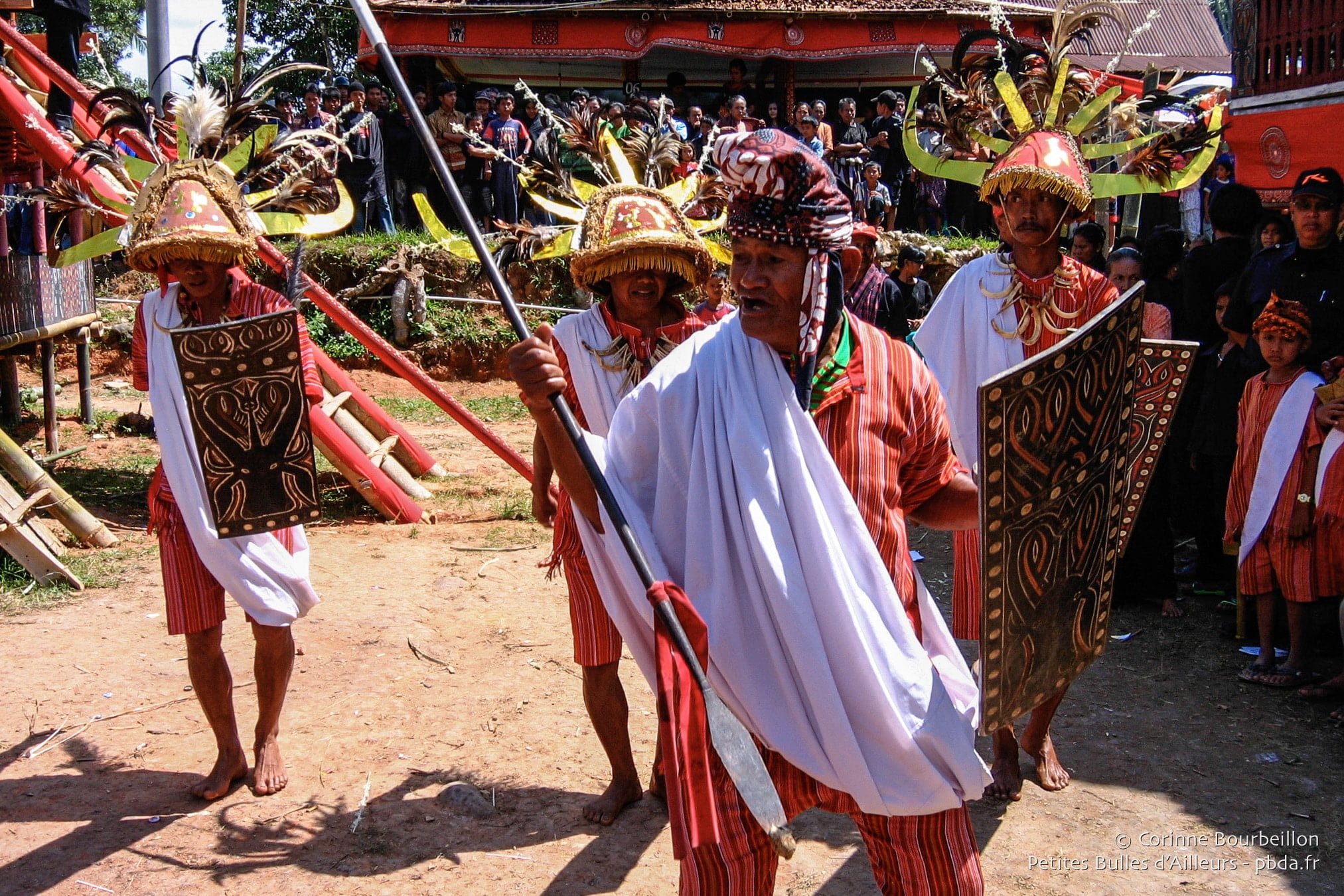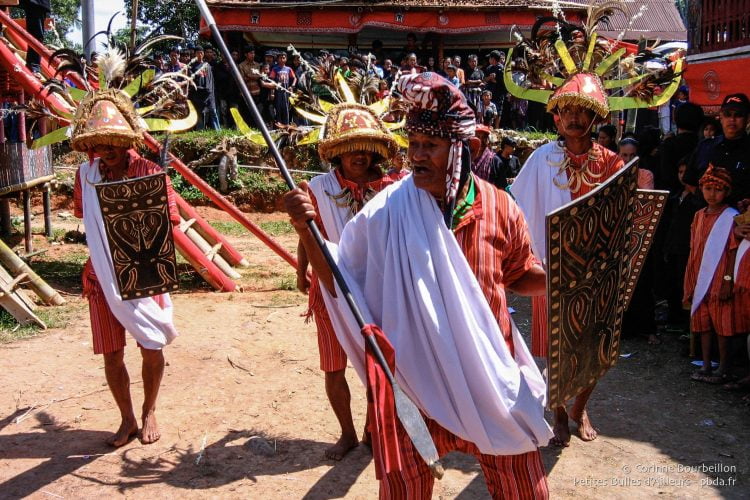Indonesia: Sulawesi - July 2007
Dear English-speaking readers, this page is an automatic translation of an article originally written in French. I apologise for any strange sentences and funny mistakes that may have resulted. If you read French, click on the French flag below to access the original, correct text:
Here I am in Toraja country (Tana Toraja) in Sulawesi. Here again, a very Christian population, and very attached to its traditions. I attended a funeral ceremony at the village of Rembon, near Rantepao. Spectacular introduction to the customs of the country ...
Everywhere, houses and rice granaries tongkonan, with this typical roof, curved like a boat hull or buffalo horns.

Funeral Toraja: the video
It is a sort of great country festival, mixing animist and Christian beliefs, for a final collective tribute to the deceased. A sumptuous ceremony, amazing, very interesting, which often lasts several days. And not at all the pure "tourist trap" that I feared a little.
In addition to the extended and close family, many outdoor guests are invited to the party. Because it's a party. Cheerful and colorful, spectacular, between animated fair and big meeting family friendly.
A funeral ceremony but festive
 Foreign tourists and other visitors are welcome. Just bring a small symbolic present (usually a cartridge of kretek, local cigarettes, does the trick).
Foreign tourists and other visitors are welcome. Just bring a small symbolic present (usually a cartridge of kretek, local cigarettes, does the trick).
I went there with a Dutch family, Suzanna, Johan and their three children, with whom I made friends in the Makassar-Rantepao bus. Eight hours of travel, it leaves time to make the chat...
To go to the ceremony, we chartered a minibus model "large family", with a guide, for this first day, although they as me appreciate the independence, question travel. But we did well.
The region being touristy, we find here people who speak English, and even French, and the explanations of the guide enlightened us well on the strangeness of this burial, very far from our Western rites.
One of the granddaughters of the deceased, who came for the occasion from Makassar, where she lives, welcomed us very kindly in excellent English and immediately put us at ease.

The outside "guests" are invited to sit on mats, under some kind of numbered canopies. We were served food and drink.
The young woman cordially invited us to take all the desired photos, to film, to circulate everywhere, among the crowd or the kids running in all directions, among the dancers in traditional costumes, shimmering silk shirt and black sarong, between the buffaloes with horns adorned with golden paper and pigs sprawled in slush.
We are a little unimpressed at first. However, there is nothing forced or overpowering about this funeral ceremony. It is the opposite.
The family and the Indonesian guests themselves, armed with video cameras and still cameras, are shooting. Suzanna and Johann's three children, blonde as wheat, are the big attraction. Everyone wants to pose with them. Even the widow, who has little Jelle, 7 years old, sitting in her palanquin next to her...
It is a joyful, animated celebration. Speeches, songs, prayers, dances follow one another in the dirt courtyard, where the bright red wooden coffin is enthroned, into which the body of the deceased will be transferred.
A deceased who has been waiting patiently for two years, embalmed and mummified in his temporary bamboo coffin, using medicinal plants and cloths ... "Our" death has been dead for a long time.
But not quite, according to Toraja rites. As long as he is kept at home, until the money for a proper funeral is collected, he is considered to still belong to the world of the living, much as a person in a coma would be for us.

Summer, July-August, is the season of funerals. There are funerals everywhere, almost every day, in the Toraja villages around Rantepao, a big, dirty and unattractive town, but where the people are very nice. For the ceremony in Rembon, where I was with the Dutch, it was the day of the procession.
Buffalo sacrifices
The coffin is placed in a kind of bamboo palanquin, with a roof tongkonan. The men hoist him on their shoulders and make him jump and dance, uttering shrill cries and screams of joy, preceded by the procession of women in black, holding over their heads a long strip of red cloth.
At the head of the parade, dancers, with spears and shields, who jump up and down with enormous bursts of laughter. The buffaloes that will be sacrificed close the march.
Everyone follows and accompanies the procession in a joyous scramble, running to the right and left to see better, to take another picture, to catch up with the rest of the family.
Afterwards, back to the funeral house, and sacrifice of a first buffalo, followed by new songs and dances. Not very tasty (I won't show you the picture), but the guy knew exactly where to cut. "Clean" and fast, despite everything.
An impressive spray of blood spurts out, as soon as the gesture is completed. The beast collapses. In a minute or two it is over. The dancers form their circle around the sacrificed buffalo.
There, we left. The Dutch had quickly moved their two daughters and son away, but the eldest, who was very sensitive, cried her eyes out when she saw the corpse of the buffalo on the ground...
New trip in 2010
Small addition. Three years later, in 2010, I went back to Sulawesi, in Toraja country, where I again attended an important funeral ceremony, almost in every way similar, with the same rituals. See videos and photos at the end of these links :
→ Toraja Country: the return
→ Toraja Funeral: the video




